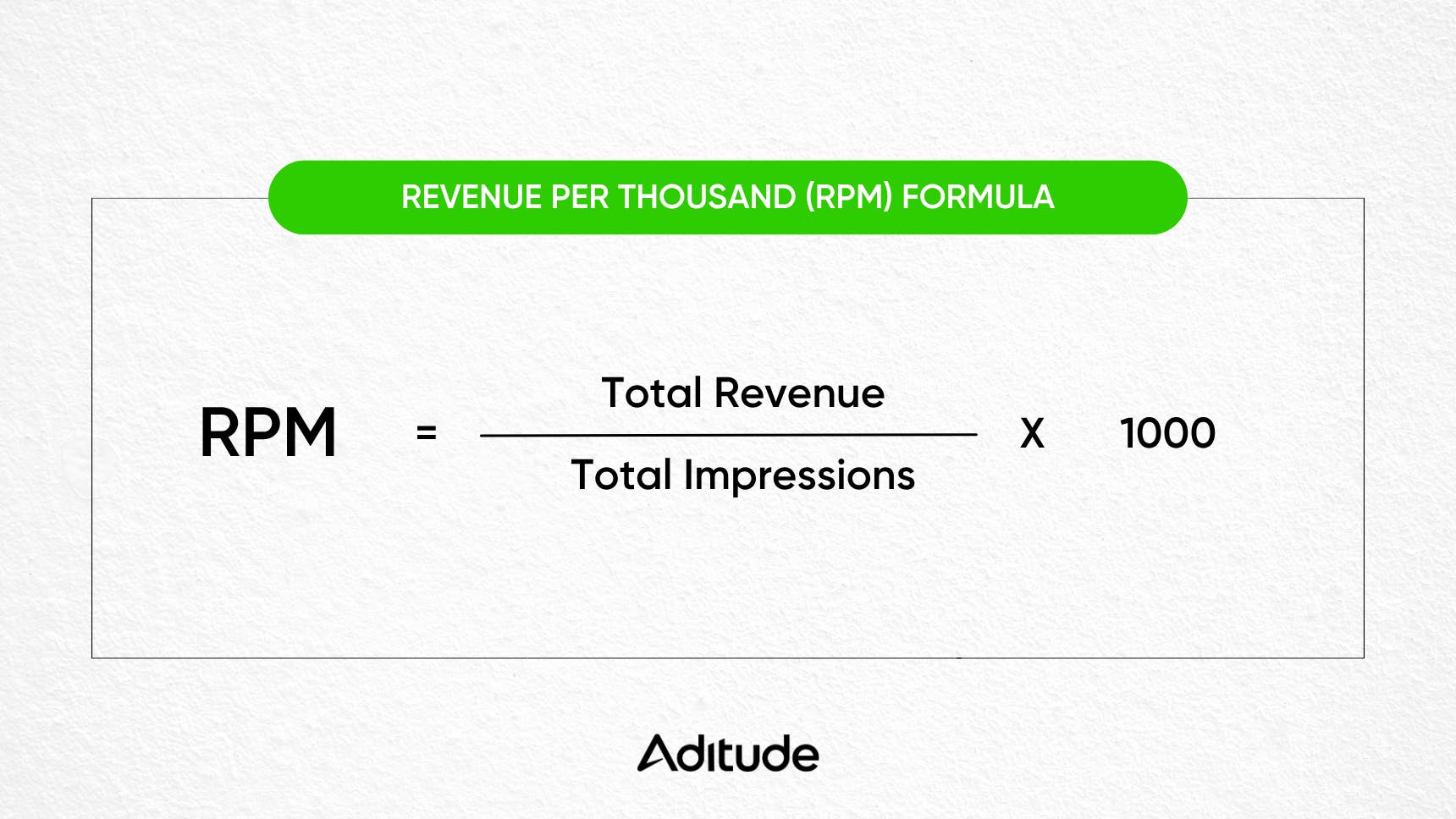RPM for Publishers: The Complete Guide to Maximizing Your Revenue Per Mille
Learn how to calculate and optimize Revenue Per Mille (RPM) to maximize your website's ad revenue. Complete guide covering RPM benchmarks, optimization strategies, and proven techniques to increase earnings per 1,000 page views.

In the digital advertising landscape, publishers are constantly seeking ways to optimize their revenue streams and understand the true value of their content. Among the various metrics that matter, Revenue Per Mille (RPM) stands out as one of the most crucial indicators of a publisher's monetization success. Whether you're managing a blog, news site, or any content-driven platform, understanding RPM can be the difference between sustainable growth and stagnant earnings.
RPM provides publishers with a clear picture of how much revenue they're generating per thousand page views or impressions, making it an essential metric for evaluating advertising performance and making informed decisions about content strategy and ad placement. This comprehensive guide will walk you through everything you need to know about RPM, from basic calculations to advanced optimization strategies.
What is RPM (Revenue Per Mille)?
Revenue Per Mille, commonly abbreviated as RPM, is a critical metric that measures the estimated earnings a publisher generates for every 1,000 impressions or page views on their website. The term "mille" comes from Latin, meaning "thousand," which is why RPM is sometimes referred to as "revenue per thousand."
RPM differs from other advertising metrics like CPM (Cost Per Mille) in that it represents the publisher's perspective rather than the advertiser's. While CPM shows how much an advertiser pays for 1,000 ad impressions, RPM shows how much a publisher earns from those same impressions after the ad network takes its share.
This metric is particularly valuable because it provides a standardized way to compare revenue across different traffic volumes, content types, and time periods. For instance, a publisher can use RPM to determine whether their gaming content generates more revenue per visitor than their lifestyle content, or whether their weekend traffic is more valuable than weekday traffic.
RPM is calculated based on actual revenue earned, not just ad impressions served. This means it takes into account factors like click-through rates, conversion rates, and the overall effectiveness of ads in generating revenue. As a result, RPM provides a more accurate picture of a publisher's monetization effectiveness than impression-based metrics alone.
How to Calculate RPM: The Formula and Examples
Calculating RPM is straightforward once you understand the basic formula. The standard RPM calculation is:
RPM = (Total Revenue ÷ Total Impressions) × 1,000
Let's break this down with practical examples to illustrate how RPM works in real-world scenarios:
Example 1: Basic RPM Calculation
Suppose your website generated $500 in revenue from 250,000 page views last month. Your RPM would be:
- RPM = ($500 ÷ 250,000) × 1,000
- RPM = 0.002 × 1,000
- RPM = $2.00
This means you earned $2.00 for every 1,000 page views on your site.
Example 2: Comparing Different Content Types
Let's say you run a multi-topic blog with the following performance:
- Technology section: $300 revenue from 100,000 views = $3.00 RPM
- Lifestyle section: $150 revenue from 100,000 views = $1.50 RPM
- Finance section: $800 revenue from 100,000 views = $8.00 RPM
These calculations reveal that your finance content generates more than five times the revenue per view compared to lifestyle content, suggesting where you might want to focus your content creation efforts.
Example 3: Seasonal RPM Variations
Consider how RPM might vary seasonally:
- November (holiday shopping season): $1,200 revenue from 200,000 views = $6.00 RPM
- February (post-holiday slowdown): $400 revenue from 200,000 views = $2.00 RPM
This comparison shows how external factors like shopping seasons can significantly impact RPM, even with consistent traffic levels.
It's important to note that different platforms may calculate RPM slightly differently. Google AdSense, for example, provides detailed RPM reporting that includes various revenue sources and allows publishers to analyze performance across different dimensions.
What Constitutes a Good RPM?
Determining what constitutes a "good" RPM is complex because it varies significantly across industries, geographic locations, audience demographics, and content types. However, understanding industry benchmarks and factors that influence RPM can help publishers evaluate their performance and set realistic goals.
Industry Benchmarks and Variations
RPM rates can vary dramatically depending on your niche:
High-Value Niches (typically $5-$20+ RPM):
- Finance and investment content often commands premium rates due to high-value audiences
- Technology and software reviews attract advertisers willing to pay more for qualified leads
- Healthcare and medical content, though heavily regulated, can generate substantial RPM
- Business and professional development content appeals to advertisers targeting decision-makers
Medium-Value Niches ($2-$8 RPM):
- Travel and tourism content performs well, especially during peak seasons
- Food and cooking content has steady demand but moderate competition
- Home improvement and DIY content attracts advertisers in the home services sector
- Parenting and family content has broad appeal but varied advertiser interest
Lower-Value Niches ($0.50-$3 RPM):
- General entertainment content faces intense competition and broad audience appeal
- Gaming content, while popular, often has younger demographics with lower purchasing power
- General news and current events typically have lower RPM due to content sensitivity
- Lifestyle and general interest content often has the broadest but least targeted audience
Geographic Factors
Geographic location plays a crucial role in RPM performance:
- Tier 1 Countries (US, UK, Canada, Australia): These markets typically offer the highest RPM rates due to strong economies and high advertiser competition. Publishers targeting these audiences can expect RPM rates 3-10 times higher than those targeting developing markets.
- Tier 2 Countries (Germany, France, Japan, South Korea): These markets offer moderate to high RPM rates, with specific niches performing exceptionally well.
- Tier 3 Countries (India, Brazil, Mexico, Eastern Europe): While traffic from these regions may be high-volume, RPM rates are typically lower due to economic factors and advertiser spending patterns.
Seasonal Considerations
RPM performance fluctuates throughout the year:
- Q4 (October-December): Generally the strongest period for RPM due to holiday shopping, with increases of 50-200% over baseline rates common.
- Q1 (January-March): Typically the weakest period as advertisers reduce spending after the holidays, with RPM often dropping 30-50% from Q4 levels.
- Back-to-School Season (August-September): Certain niches see RPM increases as advertisers target educational and family-oriented content.
Benefits of Understanding and Optimizing RPM
Publishers who actively monitor and optimize their RPM gain several significant advantages that can transform their revenue potential and business sustainability.
Revenue Optimization and Predictability
Understanding RPM enables publishers to make data-driven decisions about content strategy and resource allocation. When you know which content types generate the highest RPM, you can focus your efforts on creating more of that content, leading to increased overall revenue without necessarily increasing traffic.
RPM also provides predictable revenue forecasting. If you know your average RPM and can estimate future traffic, you can project revenue with reasonable accuracy. This predictability is crucial for business planning, especially for publishers who rely on advertising revenue to fund operations and growth.
Content Strategy Refinement
RPM data reveals which topics and content formats resonate most with advertisers and audiences. Publishers can use this information to refine their editorial calendars, focusing on high-RPM content during peak advertiser spending periods and diversifying into complementary niches that maintain revenue during slower periods.
For example, a publisher might discover that their "how-to" guides generate 40% higher RPM than their news articles. This insight could lead to a strategic shift toward more educational content, ultimately increasing overall revenue without requiring additional traffic.
Competitive Advantage
Publishers who understand RPM optimization can achieve better monetization than competitors with similar traffic levels. This efficiency advantage becomes particularly valuable in competitive niches where traffic acquisition costs are high. A publisher generating $5 RPM can afford to spend more on content creation and marketing than a competitor generating $2 RPM from the same audience.
Advertiser Relationship Management
Understanding RPM helps publishers communicate more effectively with direct advertisers and ad networks. Publishers can use RPM data to negotiate better rates, demonstrate the value of their inventory, and make informed decisions about which advertising partnerships to pursue.
Common Challenges Publishers Face with RPM
While RPM optimization offers significant benefits, publishers encounter several challenges that can impact their success and revenue potential.
Ad Blocker Impact
Ad blockers represent one of the most significant challenges to RPM optimization. When users block ads, publishers lose both impressions and revenue, but page views remain constant, resulting in artificially low RPM calculations. Studies suggest that ad blocker usage affects 25-40% of web traffic, depending on the audience and content type.
Publishers must account for ad blocker usage when evaluating RPM performance and consider strategies like acceptable ads programs or alternative monetization methods to maintain revenue from blocked traffic.
Viewability and Invalid Traffic
Not all impressions are created equal. Ad viewability standards require that ads be visible to users for a minimum duration to count as valid impressions. Low viewability rates can reduce effective RPM by decreasing the number of monetizable impressions.
Invalid traffic, including bot traffic and click fraud, can also skew RPM calculations. While ad networks filter much of this traffic, publishers must monitor their analytics for unusual patterns that might indicate traffic quality issues.
Revenue Fluctuations
RPM can be highly volatile, influenced by factors beyond a publisher's control:
- Advertiser Budget Cycles: Many advertisers operate on quarterly or seasonal budget cycles, causing RPM to fluctuate predictably throughout the year.
- Economic Conditions: Economic downturns typically result in reduced advertising spending, directly impacting RPM across all publishers.
- Platform Algorithm Changes: Changes to search engine algorithms or social media platforms can affect traffic quality and advertiser demand, influencing RPM performance.
- Competition: Increased competition in popular niches can drive down RPM as advertisers have more inventory options.
Technical Implementation Challenges
Optimizing RPM often requires technical expertise that many publishers lack:
- Ad Layout Optimization: Determining optimal ad placement requires understanding of user behavior, page load times, and user experience principles.
- Header Bidding Implementation: Advanced monetization techniques like header bidding can significantly improve RPM but require technical knowledge to implement effectively.
- Page Speed Optimization: Balancing ad density with page speed requires careful optimization to avoid negatively impacting user experience and search rankings.
Proven Strategies to Increase RPM
Publishers can implement various strategies to improve their RPM performance, ranging from technical optimizations to content strategy adjustments.
Content Quality and Targeting
High-quality, targeted content typically generates better RPM than generic content. Publishers should focus on creating comprehensive, authoritative content that attracts engaged audiences and commands premium advertiser rates.
- Long-form Content: Detailed, comprehensive articles often perform better than short posts because they provide more opportunities for ad placement and tend to attract more engaged readers who are valuable to advertisers.
- Niche Expertise: Establishing authority in specific niches can attract premium advertisers willing to pay higher rates for access to qualified audiences.
- Evergreen Content: Content that remains relevant over time provides consistent RPM performance and can be optimized repeatedly for better results.
Strategic Ad Placement and Optimization
Ad placement significantly impacts RPM performance. Publishers should experiment with different ad positions, formats, and densities to find the optimal balance between revenue and user experience.
- Above-the-Fold Placement: Ads visible without scrolling typically generate higher RPM, but publishers must balance this with user experience considerations.
- In-Content Ads: Ads placed within article content often perform better than sidebar ads, as they're more likely to be seen and engaged with by readers.
- Responsive Ad Units: Implementing responsive ad units ensures optimal display across all devices, improving overall RPM performance.
Advanced Monetization Techniques
Sophisticated publishers can implement advanced techniques to maximize RPM:
- Header Bidding: This technique allows multiple ad exchanges to bid on inventory simultaneously, often increasing revenue by 10-30% compared to traditional waterfall setups.
- Private Marketplace Deals: Establishing direct relationships with advertisers can result in premium rates and more predictable revenue.
- Audience Segmentation: Using data management platforms to segment audiences and offer targeted inventory to advertisers can command higher rates.
Traffic Quality Improvements
Focusing on high-quality traffic sources can improve RPM performance:
- Organic Search Traffic: Users arriving through organic search typically have higher commercial intent and generate better RPM than social media traffic.
- Direct Traffic: Regular readers who visit directly often have higher engagement rates and are more valuable to advertisers.
- Email Marketing: Traffic from email campaigns typically converts well and generates solid RPM performance.
Understanding Pricing Models
Publishers benefit from understanding different ad tech pricing models. Different pricing models (CPM, CPC, CPA) can significantly impact RPM performance, and understanding when to use each can help optimize revenue.
The relationship between CPM, eCPM, and RPM is crucial for publishers to understand, as these metrics work together to provide a complete picture of monetization performance.
Technical Considerations for RPM Optimization
Successful RPM optimization requires attention to various technical factors that can significantly impact revenue performance.
Page Speed and User Experience
Page speed directly affects RPM in multiple ways. Slow-loading pages reduce ad viewability, increase bounce rates, and can negatively impact search rankings. Publishers should optimize their pages to load quickly while maintaining ad effectiveness.
- Lazy Loading: Implementing lazy loading for ads can improve page speed while ensuring ads load when users scroll to them.
- Ad Density Balance: Finding the right balance between ad density and page speed requires careful testing and optimization.
- Mobile Optimization: With mobile traffic representing the majority of web traffic, ensuring fast mobile page speeds is crucial for RPM optimization.
Ad Network Diversification
Relying on a single ad network can limit RPM potential. Publishers should consider working with multiple ad networks and demand sources to maximize competition for their inventory.
- Programmatic Advertising: Participating in programmatic advertising ecosystems can increase demand for inventory and improve RPM.
- Direct Sales: Establishing direct relationships with advertisers can result in premium rates and more predictable revenue.
- Ad Mediation: Using ad mediation platforms can help optimize revenue by automatically selecting the highest-paying ads from multiple sources.
Analytics and Data Management
Comprehensive analytics are essential for RPM optimization. Publishers should implement robust tracking to understand user behavior, content performance, and revenue patterns.
- Custom Tracking: Implementing custom tracking can provide insights beyond standard analytics, helping identify optimization opportunities.
- A/B Testing: Systematic testing of different ad configurations, content types, and page layouts can identify improvements to RPM.
- Cohort Analysis: Understanding how different user segments perform can help optimize content and ad strategies for maximum RPM.
Future Trends Affecting RPM
The digital advertising landscape continues to evolve, with several trends likely to impact RPM performance in the coming years.
Privacy Regulations and Cookie Deprecation
Changes in privacy regulations and the deprecation of third-party cookies are reshaping digital advertising. Publishers must adapt their strategies to maintain RPM performance in a privacy-focused environment.
- First-Party Data: Building robust first-party data collection becomes increasingly important for maintaining advertiser interest and premium rates.
- Contextual Advertising: As behavioral targeting becomes more restricted, contextual advertising may become more valuable, potentially benefiting publishers with high-quality, topically relevant content.
- Consent Management: Implementing effective consent management systems becomes crucial for maintaining monetization in privacy-regulated markets.
Artificial Intelligence and Machine Learning
AI and machine learning technologies are increasingly used in advertising optimization, potentially improving RPM performance through better ad targeting and placement.
- Automated Optimization: AI-powered optimization tools can automatically adjust ad configurations to maximize RPM based on real-time performance data.
- Predictive Analytics: Machine learning can help predict optimal content strategies and ad placements for maximum RPM performance.
- Personalization: Advanced personalization technologies may enable publishers to deliver more relevant content and ads, improving RPM.
Alternative Revenue Streams
Publishers are increasingly diversifying beyond traditional display advertising to improve overall monetization.
- Subscription Models: Combining advertising with subscription revenue can provide more stable income streams.
- Affiliate Marketing: Integrating affiliate marketing with content can supplement advertising revenue.
- Sponsored Content: Native advertising and sponsored content can provide additional revenue streams that complement traditional RPM optimization.
Conclusion
RPM represents a fundamental metric for publishers seeking to maximize their revenue potential and build sustainable online businesses. Understanding how to calculate, interpret, and optimize RPM provides publishers with the tools they need to make informed decisions about content strategy, ad placement, and business development.
Successful RPM optimization requires a holistic approach that considers content quality, technical implementation, user experience, and market dynamics. Publishers who invest in understanding and optimizing their RPM performance will be better positioned to compete in the evolving digital advertising landscape and build profitable, sustainable businesses.
The key to long-term success lies in continuous optimization, staying informed about industry trends, and maintaining a balance between revenue generation and user experience. As the digital advertising ecosystem continues to evolve, publishers who master RPM optimization will have a significant advantage in monetizing their content and achieving their business objectives.
By implementing the strategies and best practices outlined in this guide, publishers can work toward improving their RPM performance and building more successful, profitable online properties. Remember that RPM optimization is an ongoing process that requires patience, experimentation, and continuous learning to achieve optimal results.




